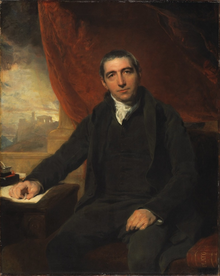
Thomas Taylor (15 May 1758 – 1 November 1835) was an English translator and Neoplatonist, the first to translate into English the complete works of Aristotle and of Plato, as well as the Orphic fragments.
Thomas Taylor was born in the City of London on 15 May 1758, the son of a staymaker Joseph Taylor and his wife Mary (born Summers). He was educated at St. Paul's School, and devoted himself to the study of the classics and of mathematics. After first working as a clerk in Lubbock's Bank, he was appointed Assistant Secretary to the Society for the Encouragement of Art (precursor to the Royal Society of Arts), in which capacity he made many influential friends, who furnished the means for publishing his various translations, which besides Plato and Aristotle, include Proclus, Porphyry, Apuleius, Ocellus Lucanus and other Neoplatonists and Pythagoreans. His aim was the translation of all the untranslated writings of the ancient Greek philosophers.
Taylor was an admirer of Hellenism, most especially in the philosophical framework furnished by Plato and the Neoplatonists Proclus and the "most divine" Iamblichus, whose works he translated into English. So enamoured was he of the ancients, that he and his wife talked to one another only in classical Greek.
He was also an outspoken voice against corruption in the Christianity of his day, and what he viewed as its shallowness. Taylor was ridiculed and acquired many enemies, but in other quarters he was well received. Among his friends was the eccentric traveller and philosopher John "Walking" Stewart, whose gatherings Taylor was in the habit of attending.
Taylor married his childhood sweetheart[2] Mary Morton, daughter of John Morton, in 1777, and they had children George Burrow Taylor (born 1779), John Buller Taylor (1781), William Grainger Taylor (1783-1785), Mary Joseph Taylor (1789) and Thomas Taylor (1791). Their eldest daughter, Mary Meredith Taylor (1787–1861), was named after his generous patron William Meredith and married a haberdasher, Samuel Beverly Jones. His wife Mary died in 1809. He married again, and his second wife Susannah died in 1823. From his second marriage he had one son, Thomas Proclus Taylor (born 1816).
Thomas Taylor died in Walworth.
The texts that he used had been edited since the 16th century, but were interrupted by lacunae; Taylor's understanding of the Platonists informed his suggested emendations. His translations were influential on William Blake, Percy Bysshe Shelley, and William Wordsworth. In American editions they were read by Ralph Waldo Emerson, Bronson Alcott, and G. R. S. Mead, secretary to Helena Blavatsky of the Theosophical Society.
Taylor also published several original works on philosophy (in particular, the Neoplatonism of Proclus and Iamblichus) and mathematics. These works have been republished (some for the first time since Taylor's lifetime) by the Prometheus Trust.
It appears that he and his wife were landlords at Walworth in the late 1770s to a family that included the 18-year-old Mary Wollstonecraft; it is not clear whether the future author of A Vindication of the Rights of Woman actually knew the Taylors, as at that age she left home for a job as a lady's companion. Taylor responded to Wollstonecraft's 1792 magnum opus (as well as Thomas Paine's "Rights of Man") in his satirical essay, A Vindication of the Rights of Brutes. In it, Taylor attempted to demonstrate the absurdity of Wollstonecraft's arguments by arguing that if the argument for equality was sound when it applied to women, why not for animals too? Wollstonecraft's reasoning seemed to hold for “brutes” too; yet, Taylor argued, to hold that brutes had rights was manifestly absurd. Therefore, Taylor contended, Wollstonecraft's reasoning must be unsound; the same arguments were used in each case, and if unsound when applied to animals, they must also be unsound when applied to women.[3]